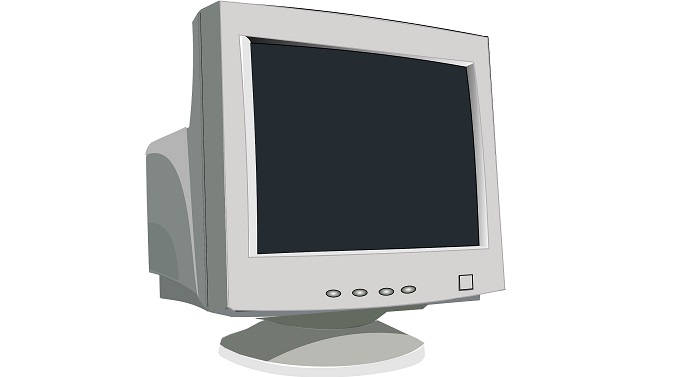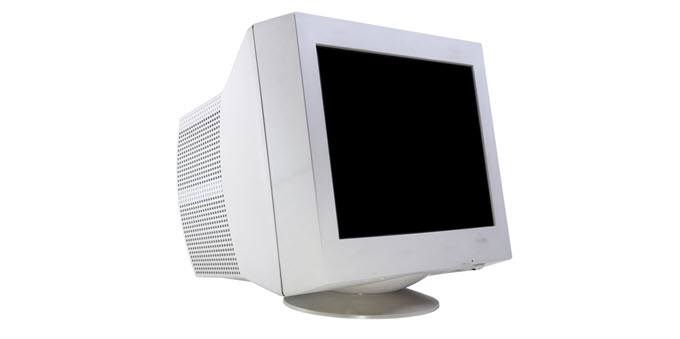Besides the nostalgia factor, a few legit reasons
Unless you’ve been following the less mainstream tech conversations going on these days, you might have missed a renewed discussion on the merits of CRT or cathode ray tube screens. Yes, we’re talking about the original ‘tube’ that has now been all but replaced by various flat panel technologies.
Believe it or not, there’s an entire generation of people who have probably never seen a CRT in real life! So why are people in tech circles talking about this older technology today? What are CRT monitors used for? Isn’t modern display tech superior?

It turns out that the answer to those questions might be more complicated than you think. Are there any good reasons to want a CRT in 2019?
They Look Good at Any Resolution
One of the biggest drawbacks of flat panel screens is that they have a “native” resolution. In other words, they have a fixed, physical grid of picture elements. So a full HD panel has 1920 by 1080 pixels. If you send an image with a lower resolution to such a panel, it has to be scaled so that multiple physical pixels act as a single virtual pixel.
In the early days scaled images on an LCD screen looked absolutely awful, but modern scaling solutions look great. So it’s not much of an issue anymore.
Still, images on a CRT look good at any resolution. This is because there are no physical pixels using this display technology. The image is drawn on the inside of the screen using electron beams, so no scaling is required. The pixels are simply drawn at the size they need to be. So even relatively low resolution images look nice and smooth on a CRT.

In the past this was a good way to gain performance in 3D apps and video games. Simply lower the resolution to get a smoother experience. With the advent of LCD technology you pretty much had to output at the native resolution, which meant cutting corners in other areas such as texture and lighting detail.
Using a CRT for high-end 3D applications means you can cut the resolution, keep the eye candy and get good performance. With almost no visual hit compared to doing the same thing on an LCD.
Blur-Free Motion
LCD flat panels use a display method known as “sample and hold”, where the current frame stays on screen in a perfectly static way until the next one is ready. CRTs (and plasma screens) use a pulsed method. The frame is drawn on screen, but immediately begins to fade to black as the phosphors lose energy.
While the sample and hold method might sound superior, the perceptual effect is a blurry image in motion thanks to the way we perceive apparent motion. Sample and hold is not the only cause of unwanted motion blur on LCDs, but it’s a big one.
Modern screens either use some form of “motion smoothing”, which leads to the dreaded “soap opera effect” or they insert black frames between the regular ones which causes brightness reduction. CRTs can show sharp motion with no brightness sacrifice and can therefore look much better when playing back video.
Incredible Black Levels
Due to the way LCDs work, it’s essentially impossible to display true black in an image. An LCD panel consists of the LCD itself, with its array of color-changing pixels and a backlight. Without the backlight, you won’t see the image. That’s because LCDs don’t give off any light of their own.

The problem is that when a pixel switches off to display black, it doesn’t block all the light coming from behind it. So the best you can get is a sort of grey tone. Modern LCD screens are much better at compensating for this, with multiple LEDs evenly lighting the panel and local backlight dimming, but true blacks are still not possible.
CRTs on the other hand can display blacks almost perfectly thanks to how it draws the picture on the back of the screen. Modern technologies like OLED does nearly as well, but is still far too expensive for mainstream consumers. Plasma was also very good in this regard, but has been largely phased out. So right now in 2019 the best black levels are still to be found in CRTs.
Some Retro Content Was Designed For CRTs
If you like consuming retro content, which includes old video games from before HD consoles and standard 4:3 aspect ratio video content, it may be best to watch them on a CRT.
It’s not that consuming this content on a modern flat panel is bad by any measure, it’s just not what the creators were using as a reference. So what you see will never match their intentions exactly.

Some video games actually took advantage of CRT quirks to generate effects such as flowing water or transparency. These effects don’t work or look odd on modern flat panels. Which is why CRTs are popular and sought after among retro gamers.
Why You DON’T Want a CRT In 2019
While there are plenty of ways in which CRTs are objectively superior to even the best modern flat panel displays, there’s also a long list of cons! After all, there’s a reason the world moved to newer display technology.
It’s also important to remember that flat panel displays at the time of the shift were far worse than those of today, yet people felt the pros of LCDs were on balance a better deal.
CRT screens are huge, heavy, power-hungry and less suitable for productivity and watching widescreen films. While their resolution limits aren’t a huge issue for video games, any sort of serious work turns into struggle with low resolution text and a lack of desktop real estate.

Despite their large size, actual screen dimensions are tiny relative to flat panels. There certainly isn’t a CRT equivalent of the 55” and larger monsters we have today. Despite the substantial image quality and motion advantages CRTs have over even the best modern flat panels, only a small niche group of people are willing to put up with the long list of drawbacks that come with CRT use.
So if you’re thinking about dabbling in the world of CRTs, make sure you know what you’re getting into.
